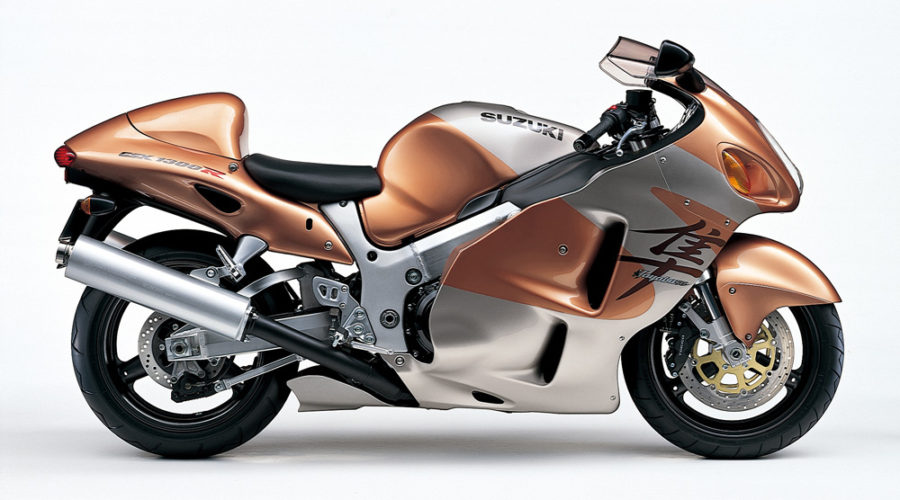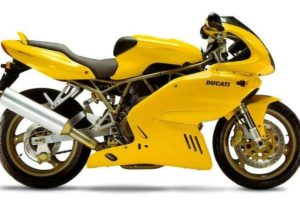1999 Suzuki GSX1300R Hayabusa
Just when you thought too much bike was barely enough, Suzuki let rip with the maddest, baddest machine we had ever seen. Mick Matheson’s roadtest of the original 1999 Hayabusa.
Your eyes aim hundreds of metres ahead. The wind blast rips at your helmet and extended knee, drowning the noise of the howling engine. The G-force glues you to the seat and tries to push your chest into the tank. The corner’s apex flashes past, the road straightens rapidly. Traction increases.
The speedo shows nearly 200km/h. You’re in third gear, the tacho pointing just below maximum power. Your right fist and the tacky 190-section Bridgestone share command of more than 100kW at the road surface. You twist. The Hayabusa rockets past 200km/h. Nothing can touch you.
The ‘Busa blitzes 200 like many machines burst the 100km/h mark. It is outrageously quick. Genuine 300km/h and more. Under 10 seconds for a quarter mile. Easily the most powerful production bike in the world. It is so fast you have to re-arrange your brain when you first go for a ride.
And at the same time it is so easy to ride. This is a bike that intimidates almost everyone who hasn’t ridden it and stuns those who have. No-one can believe how unremarkable the ‘Busa is; it is entirely at your command and only does what you tell it to do. And it handles, steers and stops so well that you’ve got to be a goose to get it wrong.
I could rattle off a dozen great moments on the new Suzuki. It has a fun factor of 10. I left home one morning and, just for the hell of it, whacked on the power in first from 6000rpm just to see if it’d wheelstand or wheelspin. It did both. At the same time.

I got clocked at 29lkm/h on a runway with a sidewind that was strong enough to make the front end skip sideways every second or so. I rode 600km in six hours, including almost two hours commuting and a lunch stop, all without trying to go particularly fast. I spent every single kilometre of this test with a grin on my face.
Without repeating all the guff from the launch (TW, May ’99), the GSX1300R is a typical four-cylinder fourstroke engine gripped in a typical twin-spar aluminium chassis with a wheel at each end. It has the usual double overhead thingies and inverted whatsits and twin-piston doo-dahs. There is nothing in the basic specs to say it goes so fast. It’s all in the little things, and in an exceptionally well-conceived engine management system and ultra-slippery aerodynamics.
The engine makes monster power. Snap it in first from about six grand and the front end shoots skywards. It absolutely eats the old powermonger, Honda’s Blackbird. Everywhere. At 8000rpm it has 15kW more. The power delivery is almost perfect, with no dips.
Open the throttle in top from idle and it surges ahead. It moans like it wants to suck air but the lungs can’t quite open, yet speed piles on. It can build deceptively if you’re not watching. Suddenly, you’re 10, 20, 30 km/h faster than you should be. But your brain adjusts as you get to know the bike a little better.
That sort of flexibility is fantastic, but the funny thing is you can still get caught in a gear too high sometimes. I suppose it’s all relative, but it happens. The bulky 249 kg fuelled-up weight holds it back at these times. But when you keep the Hayabusa spinning above 4000 rpm you’re always happy. From 6000 rpm up it’s all mind-blowing.
The chassis is as impressive. The Hayabusa looks big in pictures, shrinks when you stand near it and becomes small when you swing a leg over. It feels no bigger than a 900, say, a ZX-9R. And it handles and steers like one. This is no litre-class big-bike like the CBR1000, CBR1100 and ZZ-R1100.
Suspension feels inspired by the GSXRs, with a sporty, firm ride that is just on the harsh side when you get motivating. It’ll kick on some bumps when you’re up it for the rent, but stays pretty much on line and doesn’t feel like the front end wants to tankslap. There’s no looseness at all. This helps maintain a neutral steering response that, as long as you don’t brake too deeply into corners, gets you in and out of bends without any fuss. The Hayabusa is more predictable – and therefore faster and safer – along gnarly roads than most bikes, no matter what class they come from.
It all makes the Hayabusa the absolute quickest cross-country blaster you could lay your hands on.
Yet when you slow the pace and just want to enjoy the scenery, the Suzuki settles back and cruises with you. It shows 4000 rpm at 120 km/h in top gear and is moving effortlessly. But then, at 180 km/h it is so relaxed you hardly believe you’re going that fast.

The injection is not too sharp unlike so many electronic set-ups, and the ‘Busa is easy to ride in the rain despite the potential to spin up the back end at almost any time. The suspension, while not plush like a tourer, is comfortable enough.
Nail the front brakes from massive speeds and the front end plants its full weight on the tyre and makes it squirm in protest. It is obscenely easy to get the back end light and squirrelly on a bike this heavy, but the brakes are that good. The bike stands up a bit and pushes wide if you go too far into a corner on the brakes, but that’s not unusual in a big roadbike. Better to brake early and turn more willingly. The rear brake has above-average strength and feel, making it a useful tool at lower speeds.
The sleek fairing has a low screen – so low you can see reflections off the top of it. A side effect of excellent 300km/h windcheating is that at more realistic (but still highly illegal) speeds you have to crouch low on the tank to get out of the blast. There is virtually no turbulence, though, until well past 160km/h — just a smooth, but forceful flow of air over the top.
Some vibration creeps into both handlebars, just enough to irritate your hands at legal speeds. But otherwise the Hayabusa is comfortable. You don’t have to stretch to the handlebars, or curl your legs tightly on the footpegs. The seat is firm, but good, for at least a few hundred kilometres at a time. It is a little sportier for rider and pillion than the Blackbird or ZZ-R1100, but good all the same.
Suzuki is the most adventurous stylist of the four Japanese brands. There was the Katana of the early Eighties, then the radically different GSX-R750 and 1100. Lately it’s been the RF series and the GSX750F. The Hayabusa is another in a long line of fashion risks by the Hamamatsu crew.
There’s no denying the brown one is ugly, but when you see the Suzuki in red and black it is a completely different machine – even good-looking. The shape makes sense, too, of course: it is extremely aerodynamic.
Suzuki has beaten its previous record on finish and quality. The Hayabusa is refined and detailed like no Suzuki before it and a treat to look over. The upper triple clamp, with its Hayabusa badge, is especially nice. The dash is well designed, but partly hidden by the low screen when you’re sitting upright. The optional centrestand, or a race-type stand, would be worth buying.

There will only be two things that make life hard for the Hayabusa buyer: keeping a licence and paying for tyres. Fuel is another cost – consumption is high – and the rear tyre doesn’t last long. Heavy testing, including a series of top-speed runs that did a lot of damage, destroyed a tyre in 1700 km. Even Bridgestone only expects 3000 km from the rear.
So the god of power demands regular sacrifices of expensive rubber. Big deal. Everything else about the Hayabusa is stunning. It is more than we expected. Its engine is so much more explosive than anything else, yet so gentle in its power delivery. Its chassis is compact, controlled and capable of harnessing all the power. The Hayabusa is what a massively powerful bike should be: smooth, safe and exciting.
Buy a ‘Busa and you won’t need any other excitement in your life. It all comes down to one simple fact: at 9400rpm you’ve got 114kW right there at the hot end of a 190 section tyre.
Twist it.
By Mick Matheson. Two Wheels, August 1999

Guido from AllMoto owns a Hayabusa and reckons it’s eminently collectible. If you fancy riding in a totally different time and space continuum, do it here.




